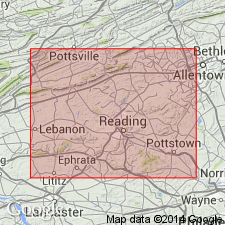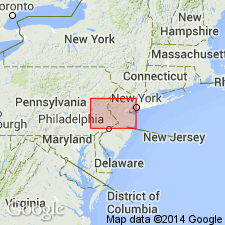
- Usage in publication:
-
- Spitzenberg conglomerate
- Modifications:
-
- Named
- Dominant lithology:
-
- Conglomerate
- AAPG geologic province:
-
- Appalachian basin
Summary:
A conglomerate body overlying Martinsburg Shale and capping the Spitzenberg in Berks Co., PA, is named the Spitzenberg Conglomerate. It consists of massive and cross-bedded sandstone interbedded with conglomerate lenses. The varying size and composition of the pebbles suggest that they are alluvial fan deposits and may represent a Triassic outlier.
Source: GNU records (USGS DDS-6; Reston GNULEX).

- Usage in publication:
-
- Spitzenberg outlier*
- Modifications:
-
- Age modified
- AAPG geologic province:
-
- Appalachian basin
Summary:
The Spitzenberg outlier consists of red and green weathering conglomeratic sandstone and conglomerate. Conodont stratigraphy shows that the clasts, composed of chert, calcisiltite, shale, sandstone, and siltstone, are youngest at the bottom of the unit and oldest at the top. The nearby Sharps Mountain outlier consists of greenish-white weathering sandstone. Both outliers contain reworked sediments of the Hamburg klippe and the Lehigh Valley sequence. They unconformably overlie and are possibly in thrust contact with rocks of the Hamburg klippe, and the Sharps Mountain outlier unconformably underlies the Tuscarora Sandstone. Age is Late Ordovician.
Source: GNU records (USGS DDS-6; Reston GNULEX).
For more information, please contact Nancy Stamm, Geologic Names Committee Secretary.
Asterisk (*) indicates published by U.S. Geological Survey authors.
"No current usage" (†) implies that a name has been abandoned or has fallen into disuse. Former usage and, if known, replacement name given in parentheses ( ).
Slash (/) indicates name conflicts with nomenclatural guidelines (CSN, 1933; ACSN, 1961, 1970; NACSN, 1983, 2005, 2021). May be explained within brackets ([ ]).

